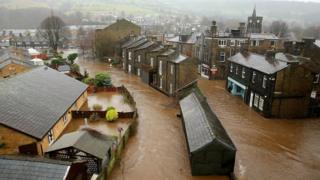 Image copyright Getty Images
Image copyright Getty Images
At a loss to know what to do with your self-isolation time?
Well, why not get on the computer and help with a giant weather digitisation effort?
The UK has rainfall records dating back 200 years or so, but the vast majority of these are in handwritten form and can't easily be used to analyse past periods of flooding and drought.
The Rainfall Rescue Project is seeking volunteers to transfer all the data into online spreadsheets.
You're not required to rummage through old bound volumes; the Met Office has already scanned the necessary documents - all 65,000 sheets.
You simply have to visit a website, read the scribbled rainfall amounts and enter the numbers into a series of boxes.
"If you do just a couple of minutes every now and then - that's great," said Prof Ed Hawkins. "If you want to spend an hour doing 30 or 40 columns - then that'll be amazing. But any amount of time, it will all add up and be a tremendous help."
If you want to take part, click here.
The Reading University scientist has run a number of previous "weather rescue" projects, including the digitisation of data collected by three men who lived atop Britain's tallest mountain, Ben Nevis, at the turn of the 20th Century. But this project is the biggest yet.
It's looking to fill the yawning gap in UK digital rain gauge records between the 1820s and 1950s.
Each of the 65,000 scanned sheets contains the monthly rainfall totals for a particular decade at a particular station. Something like three to five million data points in all.
But if Prof Hawkins' team can convert this information into a computer-friendly format, it could lead to a much better understanding of the frequency and scale of big droughts and floods. And that will assist with planning for future flood and water-resource infrastructure.
For example, many across the country had a sodden start to the year because of heavy rainfall. But meteorologists suspect the October of 1903 was just as bad, if not worse. Unfortunately, because all the rainfall data from the time was noted down on paper, it's not possible to be precise.
Likewise, there were some very dry springs and winters in the 1880s and 1890s. Britain had six or seven very dry winters and springs on the trot.
If that happened today, it would probably cause quite serious problems for the water companies because they rely on wet winters and wet springs to recharge the reservoirs.
"Water companies have to plan for a one-in-100 or one-in-500-year drought," said Prof Hawkins. "But we've only got 60 years of very dense digital data, and so it's very hard for them to come up with reliable estimates.
"We know there are periods in the past that, if they happened again, would probably break the system. And the same is true for very heavy rainfall and floods," he told BBC News.
If you want to take part, click here.
Jonathan.Amos-INTERNET@bbc.co.uk and follow me on Twitter: @BBCAmos
from Hacker News https://ift.tt/33NFppd
No comments:
Post a Comment
Note: Only a member of this blog may post a comment.